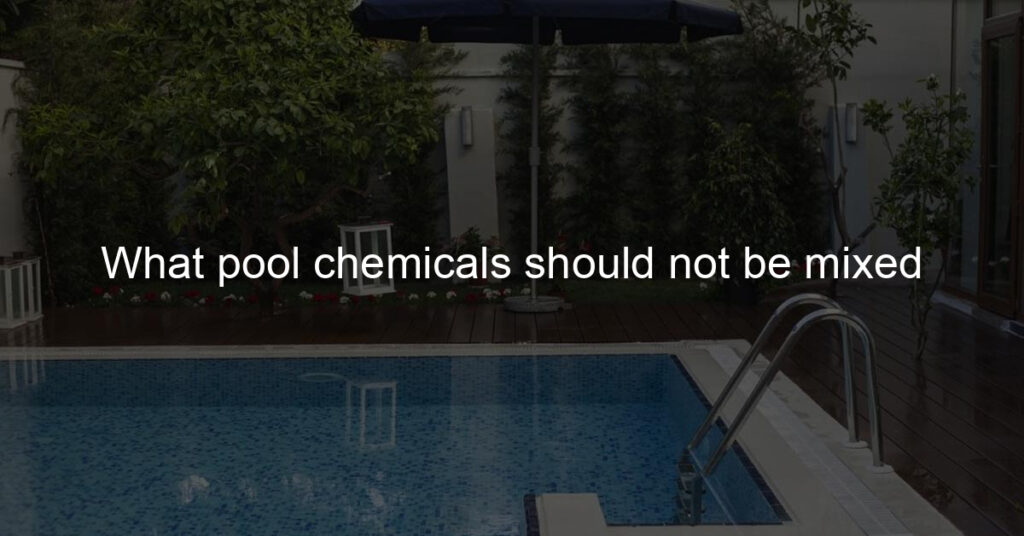When you own a swimming pool, it’s important to understand the basics of chemically maintaining your pool. Even if you outsource cleaning and maintenance responsibilities to a professional, it pays off to know what chemicals should and shouldn’t be used–and when they should not be mixed. While some chemical agents can work in tandem, others will create extremely hazardous reactions that may further damage your pool and even cause injury!
What pool chemicals cannot be added together?
When it comes to maintaining the cleanliness of swimming pools, knowing which pool chemicals you can and cannot add together is essential for keeping your pool safe. Unfortunately, some chlorine-related pool chemicals should never be mixed with acids or other sanitizing products.
Doing so could cause harm to people who use the pool by producing dangerous fumes or reacting with other chemicals to create harsh irritants. While not all combinations of pool chemicals are dangerous.
It’s best to keep them separated to avoid any potential damage. Taking the time to properly research each type of chemical you intend on using in the pool will go a long way toward guaranteeing a safe environment.
Is it okay to mix two pool chemicals?
Mixing two pool chemicals can have potentially dangerous consequences. Although it may seem like a quick and easy way to save time, this method of chemical maintenance can be incredibly hazardous to both you and your pool.
Most instructions regard any type of pool-chemical combination as inadvisable at best, so it’s best to consult with a professional before deciding on any kind of tweak to your routine maintenance plan. With that said, sometimes the chemistry of a given pool’s environment may require such a combination – just make sure to seek out an expert beforehand!
What pool chemicals need to be separated?
Separating the right pool chemicals is an essential step in remaining safe and maintaining a healthy swimming environment. Chlorine, shock, algaecides, and pH balancers are four common pool chemicals that must be stored separately.
When chlorine and shock come into contact with each other, they produce a highly toxic reaction that can sicken swimmers. Algaecides can neutralize the effects of chlorine when mixed.
Also, if paired with certain pH balancers, algaecides can create an unpleasant smell or corrode the sides of the pool. To ensure the optimal safety and performance of all your pools chis necessary to keep them separated from one another.
Can you add pool acid and chlorine at the same time?
Adding pool acid and chlorine at the same time can be a tricky business. While they can both work towards keeping your pool clean and healthy, they must be added separately to prevent certain reactions from taking place.
You should also never add chemicals without first dissolving them in a bucket of water, or you may find yourself facing some costly repair bills! To ensure you’re using your pool chemicals safely and efficiently.
It’s best to follow your swimming pool’s owner’s manual for advice about the dosages, timings, and combinations of each chemical needed for proper maintenance. This will help keep your pool in tip-top shape all summer long—enjoy!
How long after muriatic acid can you add chlorine to the pool?
If you’re using muriatic acid to treat your pool water, you’ll need to be patient if you plan on adding chlorine afterward. Generally speaking, it is best practice to wait at least 15 minutes before introducing chlorine into the pool after muriatic acid treatment.
This allows the acidic content of the water to reduce and also keeps any shock from happening due to an imbalance in pH or alkalinity levels. After making sure the water is safe, chlorine can safely be added and will help maintain a healthy level of cleanliness in the pool. In other words, no more waiting – time to jump in!
In what order should pool chemicals be added?
Staying on top of your pool’s chemical balance can seem overwhelming, but following a few simple steps make it a breeze! Generally, the water should be tested first to ensure the pH and other levels are within the required range.
After confirming all the readings are accurate, chlorine should be added first, followed by any algaecides or clarifiers. Balance chemicals like a stabilizer and pH increasers or decreasers come next and then a shock is added last. Accurate testing and proper chemical maintenance will help you get more out of every pool day!
Conclusion
Well, there you have it—now you know the basics when it comes to pool chemical safety. If you keep these simple tips in mind, you’ll be a pro at avoiding dangerous pool chemistry mishaps and protecting your family, pets, and the environment. Whether you’re an experienced swimmer or diving in for the first time this season, it’s essential to remember that there can be serious consequences associated with combining chemicals inappropriately.














